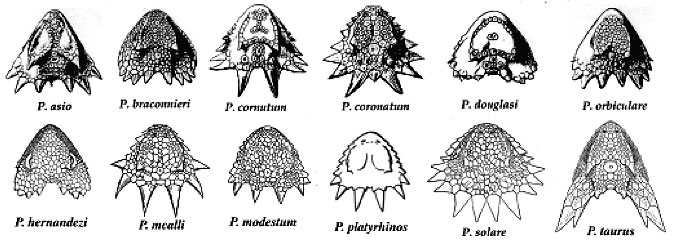You can download a printable pdf with 8 different species of Horned Lizards found in the U.S. HERE.
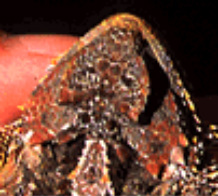
Pygmy Short-horned Lizard (Phrynosoma douglasii)
The Pygmy Short-horned Lizard is found in the Pacific Northwest from northern California through Oregon and Washington to British Columbia, Canada, and east through southeastern Idaho. The species occurs in forest habitats and open plains with sagebrush at elevations from about 400 to 8,000 feet. Phrynosoma douglasii can be distinguished from other horned lizards by its small adult size of only 2-3 inches, one row of abdominal fringe scales, and head spines that are very short and reduced with a deep notch between them. Their back scales are irregular in size and distribution and set in a rosette of smaller, keeled scales while scales on their ventral (belly) side are smooth.
The Pygmy Short-horned Lizard is found in the Pacific Northwest from northern California through Oregon and Washington to British Columbia, Canada, and east through southeastern Idaho. The species occurs in forest habitats and open plains with sagebrush at elevations from about 400 to 8,000 feet. Phrynosoma douglasii can be distinguished from other horned lizards by its small adult size of only 2-3 inches, one row of abdominal fringe scales, and head spines that are very short and reduced with a deep notch between them. Their back scales are irregular in size and distribution and set in a rosette of smaller, keeled scales while scales on their ventral (belly) side are smooth.
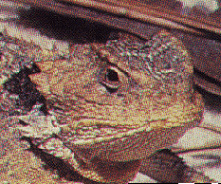
Greater Short-horned Lizard (Phrynosoma hernandesi)
The Greater Short-horned Lizard is a wide-ranging species; it occurs from southern Alberta and Saskatchewan, Canada, through Montana, Wyoming, Utah, Colorado, Arizona, New Mexico, Texas, then through northeastern Sonora, Chihuahua, and Durango, Mexico. The species lives in short-grass communities of the northern Great Plains, in sagebrush and greasewood of the Great Basin, and on mountain hillsides and valleys with pine, juniper, aspen, and coniferous forests throughout its range. The species is found between 2,000 and 10,400 feet in elevation. Phrynosoma hernandesi can be distinguished from other horned lizard species by the following: one row of abdominal fringe scales, reduced central horns separated by a deep notch and slightly longer side horns, back scales are arranged in 6-8 rows.
The Greater Short-horned Lizard is a wide-ranging species; it occurs from southern Alberta and Saskatchewan, Canada, through Montana, Wyoming, Utah, Colorado, Arizona, New Mexico, Texas, then through northeastern Sonora, Chihuahua, and Durango, Mexico. The species lives in short-grass communities of the northern Great Plains, in sagebrush and greasewood of the Great Basin, and on mountain hillsides and valleys with pine, juniper, aspen, and coniferous forests throughout its range. The species is found between 2,000 and 10,400 feet in elevation. Phrynosoma hernandesi can be distinguished from other horned lizard species by the following: one row of abdominal fringe scales, reduced central horns separated by a deep notch and slightly longer side horns, back scales are arranged in 6-8 rows.
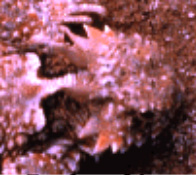
Desert Horned Lizard (Phrynosoma platyrhinos)
Desert Horned Lizards have a widespread range from Oregon and Idaho, south through Utah, Nevada, western Arizona, southern California and into northeastern Baja and northwestern Sonora, Mexico. They occur at elevations from below sea level to about 6,600 feet throughout the Great Basin, Mojave, and Sonoran Deserts. The species can be found near woody shrubs, cacti, rocks and yuccas in alluvial fans, flats, washes, and valleys. Phrynosoma platyrhinos has two long central horns and shorter side horns. Desert horned lizards have a single row of abdominal fringe scales and a smooth back with a few scattered, larger spines.
Desert Horned Lizards have a widespread range from Oregon and Idaho, south through Utah, Nevada, western Arizona, southern California and into northeastern Baja and northwestern Sonora, Mexico. They occur at elevations from below sea level to about 6,600 feet throughout the Great Basin, Mojave, and Sonoran Deserts. The species can be found near woody shrubs, cacti, rocks and yuccas in alluvial fans, flats, washes, and valleys. Phrynosoma platyrhinos has two long central horns and shorter side horns. Desert horned lizards have a single row of abdominal fringe scales and a smooth back with a few scattered, larger spines.
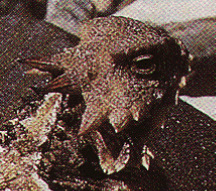
Coast Horned Lizard (Phrynosoma coronatum)
Coast Horned Lizards live along the Pacific Coast of California to the tip of Baja California, Mexico, and they are found in chaparral, oak woodland, coniferous forest, inland valleys, foothills and mountainsides from sea level to 6,600 ft. in elevation. Phrynosoma coronatum has two long central horns on its head, sometimes with a short horn or scale in between them. The side horns are also long, and this species has two rows of abdominal fringe scales. The scales on this species' back are elongated and keeled, giving it an overall spiny appearance
Coast Horned Lizards live along the Pacific Coast of California to the tip of Baja California, Mexico, and they are found in chaparral, oak woodland, coniferous forest, inland valleys, foothills and mountainsides from sea level to 6,600 ft. in elevation. Phrynosoma coronatum has two long central horns on its head, sometimes with a short horn or scale in between them. The side horns are also long, and this species has two rows of abdominal fringe scales. The scales on this species' back are elongated and keeled, giving it an overall spiny appearance
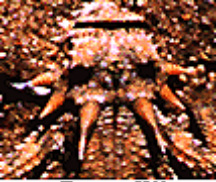
Flat-tailed Horned Lizard (Phrynosoma mcallii)
Flat-tailed Horned Lizards are found only in the lower Colorado division of the Sonoran Desert in southeastern California, southwestern Arizona, northern Baja California, and Sonora, Mexico. They are found in very open habitats on a variety of soil types, from mud flats to sand dunes, typically at elevations from below sea level to 1,000 feet. Flat-tailed Horned Lizards have a long tail,which is broad and flat. Phrynosoma mcallii has two central horns, which are very long and sharp, and long side horns. The species has two rows of small abdominal fringe scales; the second row is often reduced. The species also has a dark line down the middle of the back.
Flat-tailed Horned Lizards are found only in the lower Colorado division of the Sonoran Desert in southeastern California, southwestern Arizona, northern Baja California, and Sonora, Mexico. They are found in very open habitats on a variety of soil types, from mud flats to sand dunes, typically at elevations from below sea level to 1,000 feet. Flat-tailed Horned Lizards have a long tail,which is broad and flat. Phrynosoma mcallii has two central horns, which are very long and sharp, and long side horns. The species has two rows of small abdominal fringe scales; the second row is often reduced. The species also has a dark line down the middle of the back.
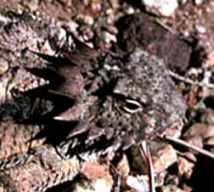
Regal Horned Lizard (Phrynosoma solare)
Regal Horned Lizards are found in the Sonoran Desert of south-central Arizona and the southwestern edge of New Mexico and south into Sonora and Sinaloa, Mexico. The species is found in arid and semiarid flats, valleys and mountain slopes with desert scrub and cactus, sometimes entering open oak and juniper woodland at elevations from sea level to about 4,800 feet. Phrynosoma solare is the only species with four central horns and elongate side horns, which form a complete crown (the scientific name, solare, means “of the sun”). They have a single row of large abdominal fringe scales and a spiny back. Background body colors are often combinations of browns, grays, and black.
Regal Horned Lizards are found in the Sonoran Desert of south-central Arizona and the southwestern edge of New Mexico and south into Sonora and Sinaloa, Mexico. The species is found in arid and semiarid flats, valleys and mountain slopes with desert scrub and cactus, sometimes entering open oak and juniper woodland at elevations from sea level to about 4,800 feet. Phrynosoma solare is the only species with four central horns and elongate side horns, which form a complete crown (the scientific name, solare, means “of the sun”). They have a single row of large abdominal fringe scales and a spiny back. Background body colors are often combinations of browns, grays, and black.
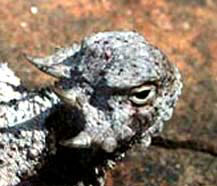
Round-tailed Horned Lizard (Phrynosoma modestum)
Round-tailed Horned Lizards occur in Chihuahuan desert and grassland communities from extreme southeastern Colorado and western Oklahoma through west Texas and New Mexico to southeastern Arizona. The range extends south into the Mexican states of Chihuahua, Coahuila, Zacatecas and San Luis Potosí. They are found on rocky substrates in desert flats, canyons, semiarid plains, and scrublands at elevations from about 600 to 7300 feet. The four short horns on the back of the head are equal in length and additional side horns are short. Their backs are not spiny. The species has round, cylindrical tails that are usually banded. Background coloration varies to match local soil, but the species does have dark blotches on the sides of the neck and shoulder area. Phrynosoma modestum is the only species that lacks abdominal fringe scales.
Round-tailed Horned Lizards occur in Chihuahuan desert and grassland communities from extreme southeastern Colorado and western Oklahoma through west Texas and New Mexico to southeastern Arizona. The range extends south into the Mexican states of Chihuahua, Coahuila, Zacatecas and San Luis Potosí. They are found on rocky substrates in desert flats, canyons, semiarid plains, and scrublands at elevations from about 600 to 7300 feet. The four short horns on the back of the head are equal in length and additional side horns are short. Their backs are not spiny. The species has round, cylindrical tails that are usually banded. Background coloration varies to match local soil, but the species does have dark blotches on the sides of the neck and shoulder area. Phrynosoma modestum is the only species that lacks abdominal fringe scales.
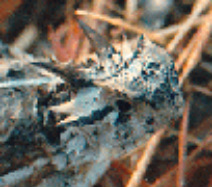
Texas Horned Lizard (Phrynosoma cornutum)
Texas Horned Lizards are found farther east than any other horned lizard. They live throughout most of Oklahoma, Kansas, New Mexico and Texas, a small section of southeastern Colorado and Arizona, and south to the Mexican states of Durango, Zacatecas, and San Luis Potosí. The species lives in arid and semiarid grasslands, chaparral and thornscrub habitats with cacti, yucca, mesquite, acacia, oak and juniper at elevations from 0 to 6,000 feet. Phrynosoma cornutum has two long central horns, often separated by a short horn or enlarged scale. The species also has sharp side horns, spiny backs and two rows of large, abdominal fringe scales. The intensity of their colors differs between individuals and populations, but they usually have a white or pale stripe down the middle of their backs and dark stripes radiating from the eye to upper lip and on the top of the head. This species is the Texas State Reptile.
Texas Horned Lizards are found farther east than any other horned lizard. They live throughout most of Oklahoma, Kansas, New Mexico and Texas, a small section of southeastern Colorado and Arizona, and south to the Mexican states of Durango, Zacatecas, and San Luis Potosí. The species lives in arid and semiarid grasslands, chaparral and thornscrub habitats with cacti, yucca, mesquite, acacia, oak and juniper at elevations from 0 to 6,000 feet. Phrynosoma cornutum has two long central horns, often separated by a short horn or enlarged scale. The species also has sharp side horns, spiny backs and two rows of large, abdominal fringe scales. The intensity of their colors differs between individuals and populations, but they usually have a white or pale stripe down the middle of their backs and dark stripes radiating from the eye to upper lip and on the top of the head. This species is the Texas State Reptile.
Photos above used by permission of Wade Sherbrooke from his book, "Introduction to Horned Lizards of North America".
Here are some fascinating links to learn more about horned lizards:
Horned Lizards, Part 1 - by Eric R. Pianka and Wendy L. Hodges
Horned Lizards - Part 2 - by Eric R. Pianka and Wendy L. Hodges
Ecology of Horned Lizards: A Review with Special Reference to Phrynosoma platyrhinos (1975)
Texas Horned Lizard (TPWD)
Texas Nature Trackers: Texas Horned Lizard Watch
Oklahoma's Most Wanted: The Texas Horned Lizard (pdf)
About Horned Lizards: Text by Dr. Wendy Hodges
Horned Lizards, Part 1 - by Eric R. Pianka and Wendy L. Hodges
Horned Lizards - Part 2 - by Eric R. Pianka and Wendy L. Hodges
Ecology of Horned Lizards: A Review with Special Reference to Phrynosoma platyrhinos (1975)
Texas Horned Lizard (TPWD)
Texas Nature Trackers: Texas Horned Lizard Watch
Oklahoma's Most Wanted: The Texas Horned Lizard (pdf)
About Horned Lizards: Text by Dr. Wendy Hodges
